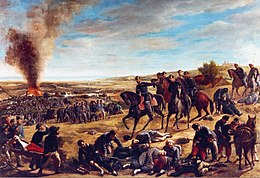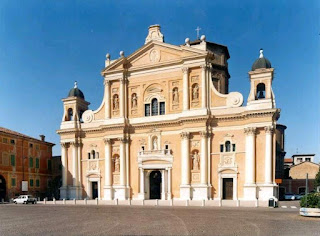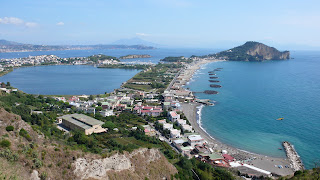Fierce fighter murdered in act of treachery
.jpg) |
| Boldrino da Panicale grew up in violent times in Italy |
He had been lured to a banquet, thought to have been staged at the Castello della Rancia, a castle about 13km (8 miles) west of Macerata, by Andrea Tomacelli, brother of Pope Boniface IX and Rector of the Duchy of Spoleto.
During an era when towns and neighbouring land changed hands regularly as rival leaders fought for territorial gains, Boldrino had been employed by Boniface IX to retake some captured parts of the Marche for the Papal States.
He handed back some of the papal territory but decided to keep other areas for himself, using the threat of violence to extract payments from local governors and hoping that he would be allowed to rule the area and be granted a marquisate.
Boniface IX had sent Tomacelli to bring peace to the region. While there was no love lost between him and Tomacelli, Boldrino accepted the invitation to the banquet, perhaps hoping that the occasion would be some sort of investiture, giving him the title he craved. Tomacelli had already agreed to impose a new tax on the area Boldrino controlled, essentially to enrich Boldrino himself.
But the occasion was not what Boldrino expected, far from it. During a break between courses, when washing his hands, he was attacked from behind and repeatedly stabbed, perhaps by Tomacelli himself, or somebody acting on his behalf. Some accounts say Boldrino was also beheaded.
 |
| Boldrino is thought to have been murdered during a banquet at Castello della Rancia |
He was born in around 1331, when fighting between rival factions in the area around Panicale was common. Boldrino was used to witnessing bloodshed from an early age. Nonetheless he looked set to have a life in farming until everything changed when his father, Ambrogio, was murdered.
Determined to take revenge, Boldrino abandoned farming and embarked on a path of violence and warfare. He moved to Perugia to train at a military college. In 1351, he learned the names of his father’s killers, returned to Panicale, found where they lived and killed them both.
Convicted in absentia for the crime by the municipal authorities in Panicale, he was forced to flee. He initially found refuge in the small church of Santa Maria La Querciolana, just outside the town, before encountering a company of mercenaries who were looking for recruits, and deciding to join them.
Quickly emerging as a highly-skilled condottiero both in combat and strategy, Boldrino’s prowess earned him a place in the company of the legendary Sir John Hawkwood, also known as Giovanni Acuto, an English mercenary who dominated Italian warfare at the time.
 |
| Boldrino fought for many years alongside Sir John Hawkwood |
In 1376, after about 14 years of service alongside Hawkwood, Boldrino established himself as an independent leader, commanding his own forces and securing territories.
He became Lord of Civitanova Marche, Arquata del Tronto, and other feudal holdings. His reputation as a ruthless yet effective commander grew, and he was frequently employed by powerful factions, including the Papal States under Pope Urban VI. His campaigns left devastation in their wake, particularly in Tuscany and the Marche region. He accumulated great wealth in the process.
His own soldiers became fiercely loyal to him, responding to his death by mounting a campaign of massacre against the people of Macerata, which ended following the intervention of mediators from Florence only when the body of Boldrino was returned to them, along with a sum of 12,000 florins as compensation.
His troops had the body embalmed and placed in an artistically made coffin, around which the troops swore never to disband. The company went on to fight successfully under the leadership of the Perugian condottiero, Biordo Michelotti.
 |
| Panicale is notable for its layout of streets in concentric ovals leading to the main square |
Panicale, in Umbria, is a mostly medieval walled town. Located on the eastern slope of Monte Petrarvella, in the southeast of Valdichiana, it overlooks Lago di Trasimeno and is about 35km (22 miles)from Perugia. It is notable in that its streets form concentric ovals that lead to the main square, Piazza Umberto I, at the centre of which is the 15th century fountain, the Fontana Maggiore. For such a small town - it has fewer than 6,000 inhabitants - Panicale has some remarkable art including two works by Pietro Perugino, one a magnificent fresco, The Martyrdom of Saint Sebastian, in the church of San Sebastiano. The 18th century Teatro Cesare Caporali is one of the smallest in Umbria. Just off Piazza Umberto I, in a small square at the start of Via Paolo Corsetti, is a 13th century building which was the birthplace of Boldrino Paneri. It carries a plaque bearing words which translate to “Boldrino, very proud leader, always crowned by victory, generous to friends, ominous to enemies.”
 |
| Macerata's 16th century Loggia dei Mercanti |
The city of Macerata, home to about 43,000 people, is situated in an inland area of Marche, about 48km (30 miles) south of Ancona and 30km (19 miles) from the coastal town of Civitanova Marche. Not a well-known tourist destination, its older part nonetheless has a charming hill town feel, with a maze of narrow cobblestone streets and one of Italy’s oldest universities, dating back to 1290. It is the setting each summer for a month-long opera festival at the atmospheric Arena Sferisterio, which has attracted some of the world’s biggest stars. Other notable attractions are the Torre Civica, which offers panoramic views, and Piazza della Libertà, the heart of the historic centre, with its 16th century Loggia dei Mercanti, where travelling merchants once sold their wares. The Basilica della Misericordia and the church of Santa Maria della Porta are also worth visiting.
Also on this day:
1603: The birth of painter Pietro Paolini
1678: The birth of painter, sculptor and architect Domenico Antonio Vaccaro
1751: The birth of Naples priest the Blessed Vincent Romano
1977: The death of film director Roberto Rossellini





.jpg)
_Tib%C3%A8re_-_Mus%C3%A9e_Saint-Raymond_Ra_342_b.jpg)



